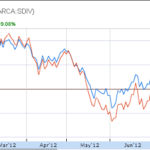The first Hedge Fund ETF launched in 2009. While even many of the most popular hedge funds took it on the chin during the financial collapse, the lure of double-digit market returns with low correlation to conventional asset classes makes the sound of a “Hedge Fund ETF” appealing. In 2009, IndexIQ launched the IQ Hedge Multi-Strategy Tracker (QAI) to much fanfare but lacks returns worthy of celebration.
While an expense ratio of 0.75% (+.33% additional fees cited with fine print) is a more appealing aspect than the typical 2% flat plus 20% of profits sophisticated investors typically pay on a hedge fund, the ETF is basically a culmination of yesterday’s market movers by sector without any discernible likelihood of beating a typical broad market index or basket of commodity ETFs over a prolonged period of time. At launch, the back-tested results looked good, but since then, it has underwhelmed. Below are listed the top 10 holdings as of last quarter. Noticeably absent from top holdings are other low correlation alternative assets like precious metal ETFs and the timber ETF that bested QAI 5-to-1 over the prior month period and 10-to-1 since launch.
Top 10 Holdings 1/1/2010
LQD iShares iBoxx $ InvesTop Investment Grade Bond Fund 18.55%
EEM iShares MSCI Emerging Markets Index Fund 15.10%
SHY iShares Barclays Lehman 1-3 Year Treasury Bond Fund 13.98%
DBV PowerShares DB G10 Currency Harvest Fund 8.65%
VWO Vanguard ETF Emerging Markets 7.02%
BSV Vanguard Short-Term Bond ETF 6.18%
HYG iShares iBoxx $ High Yield Corporate Bond Fund 4.62%
JNK SPDR Barclays Capital High Yield Bond ETF 3.27%
SHV iShares Barclays Short Treasury Bond Fund 3.07%
(Short):
Russell 2000 Futures-9.68%
One of the biggest draws of the successful hedge funds is that astute hedge fund managers actually see the trends and invest in them BEFORE the rest of the investment world jumps on the bandwagon – and they are rewarded handsomely for doing so.
For instance, one hedge fund manager made a 1000%+ return (Financial Times) for shareholders by foreseeing the imminent collapse of the housing market and all the flavors of mortgage backed securities instruments to boot. By making wagers seeking to benefit when real estate crashed with sizable leverage, the returns were enormous given what happened to a typical long-only investor. A passive ETF only has historical data and pre-determined weightings to offer. And the only “short” is the broad market itself instead of strategically shorting overpriced assets.
It’s tough for retail investors to win. While some of the ETFs embedded within QAI have performed well lately like high yield corporate bonds, and currency ETFs seeking to benefit from a crashing dollar, in a flat or upward market, QAI has not outperformed. And in a down market, is it really a winning strategy if you’re “not losing as much”? Why bother? Cash or CDs “don’t lose as much” even though they may lose money to inflation once that ship sets sail. There are plenty of hedging strategies for a trading portfolio, as opposed to buying into a hedge fund ETF that doesn’t carry some of the benefits actual hedge fund investors enjoy – like active management and positive alpha.
QAI Performance vs. S&P500
1 Month 2% vs 7%
3 Months -1% vs 4%
6 Months 1% vs 9%
QAI Fact Sheet
Disclsoure: No position in QAI.










{ 0 comments… add one now }